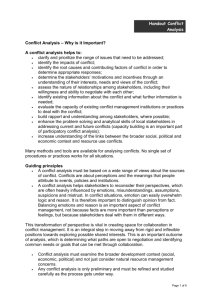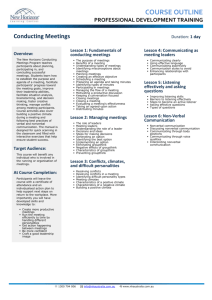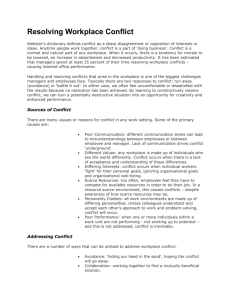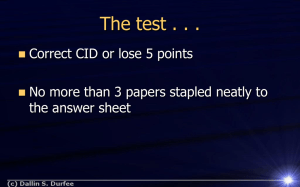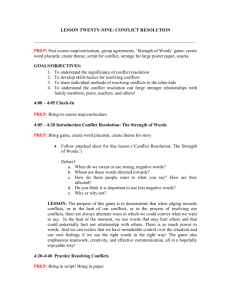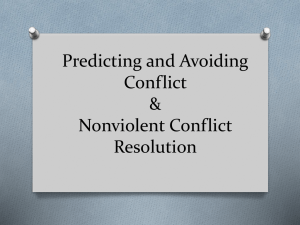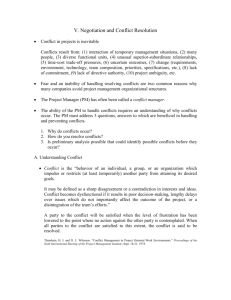Problem Solving Decision Making
advertisement
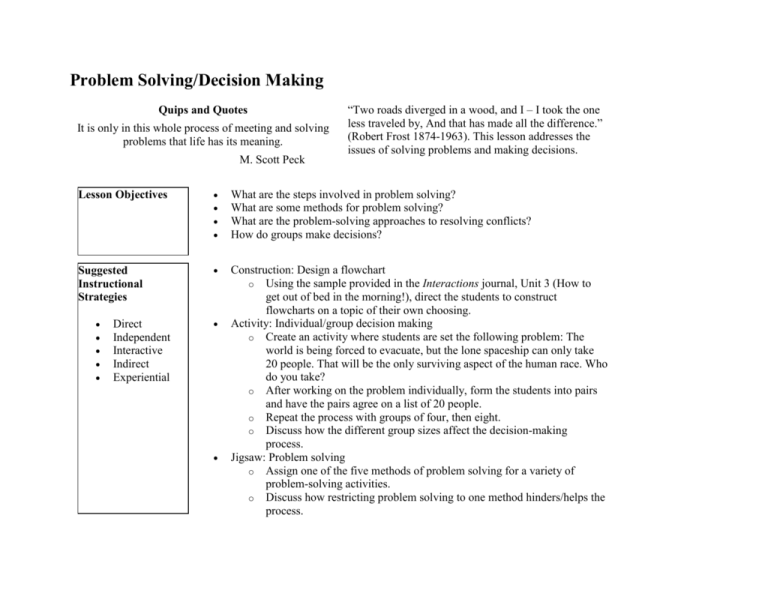
Problem Solving/Decision Making Quips and Quotes It is only in this whole process of meeting and solving problems that life has its meaning. M. Scott Peck “Two roads diverged in a wood, and I – I took the one less traveled by, And that has made all the difference.” (Robert Frost 1874-1963). This lesson addresses the issues of solving problems and making decisions. Lesson Objectives What are the steps involved in problem solving? What are some methods for problem solving? What are the problem-solving approaches to resolving conflicts? How do groups make decisions? Suggested Instructional Strategies Construction: Design a flowchart o Using the sample provided in the Interactions journal, Unit 3 (How to get out of bed in the morning!), direct the students to construct flowcharts on a topic of their own choosing. Activity: Individual/group decision making o Create an activity where students are set the following problem: The world is being forced to evacuate, but the lone spaceship can only take 20 people. That will be the only surviving aspect of the human race. Who do you take? o After working on the problem individually, form the students into pairs and have the pairs agree on a list of 20 people. o Repeat the process with groups of four, then eight. o Discuss how the different group sizes affect the decision-making process. Jigsaw: Problem solving o Assign one of the five methods of problem solving for a variety of problem-solving activities. o Discuss how restricting problem solving to one method hinders/helps the process. Direct Independent Interactive Indirect Experiential Activity: Decision making models o Review decision-making models already discussed in the course, including the “From both perspectives,” talking circles, consensus decision making and dialectical reasoning. Discussion: Life and living o Discipline is the basic set of tools we require to solve life’s problems. Without discipline we can solve nothing. There are four tools that together form a disciplined life: delay of gratification, acceptance of responsibility, dedication to truth, and balancing (M. Scott Peck, 1978, p. 15). Making Connections Moral dilemmas, see Topic 2.5.3, Moral and Ethical behaviour for additional information. Resources Poetry: “The Road Less Traveled,” by Robert Frost Interactions : Unit 3, How to get out of bed in the morning! Lesson 4.5.8: Teacher Information What are the steps involved in problem solving? Many psychologists believe that four aspects are central to problem solving: Stage 1: Stage 2: Stage 3: Stage 4: Problem identified and understood Potential solutions generated Solutions examined and identified Solutions tried and evaluated (Baron et al., 1998, p. 286). What are some methods for solving problems? Selecting an appropriate strategy is critical to effective problem solving. There are several methods for solving problems: Trial and error involves trying different responses until one works. Algorithms are rules for a particular kind of problem that will, if followed, yield a solution. Heuristics are rules of thumb we often use to guide our cognition. In terms of problem solving, heuristics involve strategies suggested by prior experience – ones we have found useful in the past. Analogies, or the application of techniques that have worked in the past. Metacognitive processing, in particular talking through the problem solving process, allow us to observe the particular steps taken to solve a problem (Baron et al., 1998, p. 287). What are the problem solving approaches to resolving conflicts? There are various approaches to resolving conflicts: In Win-Lose problem solving, one party gets what he or she wants, whereas the other comes up short. People resort to this method of resolving disputes when they perceive a situation as being an either-or one. The most clear-cut examples of winlose situations are games in which the rules require a winner and a loser. Power, authority, implied force or intellectual power are some common methods of defeating an opponent. In Lose-Lose problem solving, neither side is satisfied with the outcome. The reality is that lose-lose is a fairly common way to handle conflicts. Unlike lose-lose outcomes, a compromise gives both parties at least some of what they wanted, though both sacrifice part of their goals. In Win-Win problem solving, the goal is to find a solution that satisfies the needs of everyone involved. Not only do the parties avoid trying to win at the other’s expense, but also they believe that by working together it is possible to find a solution that goes beyond a mere compromise and allows all parties to reach their goals (Adler et al., 2001, p. 446). How do groups make decisions? The process by which members of a group reach a decision is different from the process involved in individual decision making if only because decisions in groups are usually preceded by discussion. Two examples of problems associated with group decision making are group polarization and groupthink. The group polarization effect is evident in such situations as group aggression (in which individual tendencies towards aggressiveness are magnified by the group), and bystander intervention, when helping is inhibited in group situations because individuals want to avoid looking foolish. There are three possible explanations for group polarization: o Social comparison assumes that individuals try to see themselves and present themselves to others in as favourite a light as possible. o Persuasive argumentation suggests that the preponderance of persuasive and novel argumentation in group discussion is responsible for the polarization effect. o Social identification is a process whereby individuals define themselves with respect to other people, and conform to the norms and stereotypes associated with the group (Alcock et al., 1998, p. 337). Janis (1982) has coined the term groupthink for the tendency for group members, especially elite groups, to assume that the group invariably has the right answer. It occurs when a group seeks a solution to a problem without fully considering all the possible alternatives (Alcock et al., 1998, p. 164).

